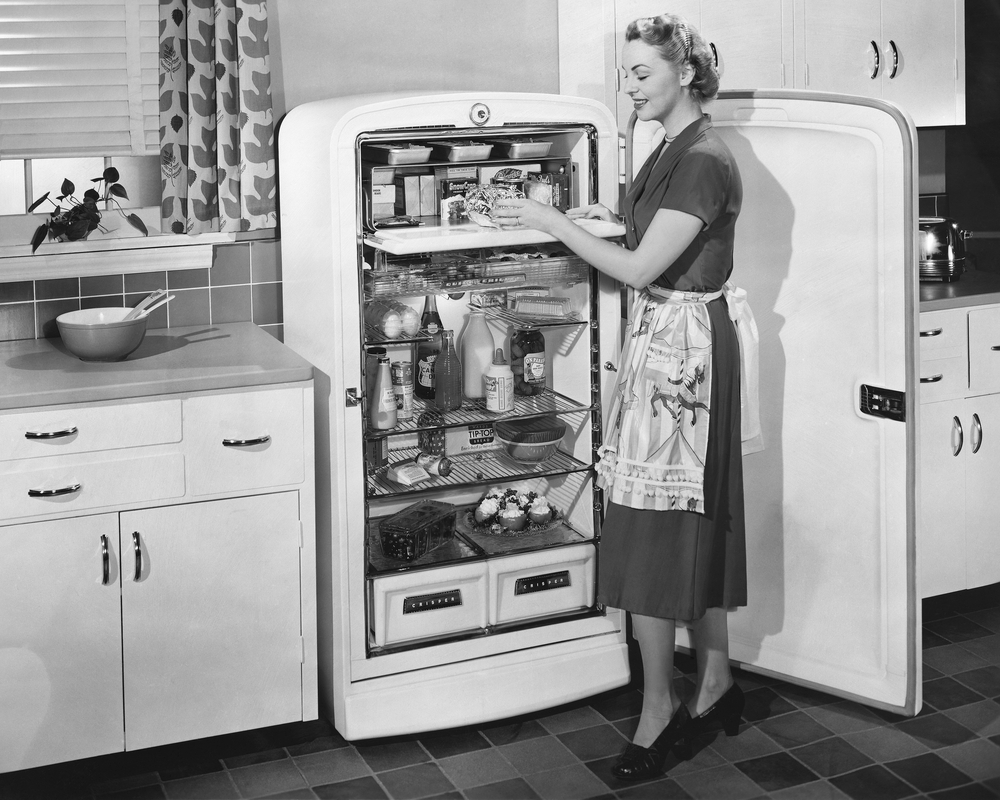Who Invented the Refrigerator?

Refrigeration is the process of creating cooling conditions by removing heat. It is mostly used to preserve food and other perishable items, preventing foodborne illnesses. It works because bacteria growth is slowed at lower temperatures.
Methods for preserving food by cooling have been around for thousands of years, but the modern refrigerator is a recent invention. Today, the demand for refrigeration and air conditioning represent nearly 20 percent of energy consumption worldwide, according to a 2015 article in the International Journal of Refrigeration.
History
The Chinese cut and stored ice around 1000 B.C., and 500 years later, the Egyptians and Indians learned to leave earthenware pots out during cold nights to make ice, according to Keep It Cool, a heating and cooling company based in Lake Park, Florida. Other civilizations, such as the Greeks, Romans and Hebrews, stored snow in pits and covered them with various insulating materials, according to History magazine. In various places in Europe during the 17th century, saltpeter dissolved in water was found to create cooling conditions and was used to create ice. In the 18th century, Europeans collected ice in the winter, salted it, wrapped it in flannel, and stored it underground where it kept for months. Ice was even shipped to other locations around the world, according to a 2004 article published in the journal of the American Society of Heating, Refrigeration, and Air-Conditioning Engineers (ASHRAE).
When ice wasn't available or practical, people used cool cellars or placed goods underwater, according to History magazine. Others built their own ice boxes, according to Keep It Cool. Wooden boxes were lined with tin or zinc and an insulating material such as cork, sawdust, or seaweed and filled with snow or ice.
Evaporative cooling
The concept of mechanical refrigeration began when William Cullen, a Scottish doctor, observed that evaporation had a cooling effect in the 1720s. He demonstrated his ideas in 1748 by evaporating ethyl ether in a vacuum, according to Peak Mechanical Partnership, a plumbing and heating company based in Saskatoon, Saskatchewan.
Oliver Evans, an American inventor, designed but did not build a refrigeration machine that used vapor instead of liquid in 1805. In 1820, English scientist Michael Faraday used liquefied ammonia to cause cooling.
Jacob Perkins, who worked with Evans, received a patent for a vapor-compression cycle using liquid ammonia in 1835, according to History of Refrigeration. For that, he is sometimes called the "father of the refrigerator."
Get the world’s most fascinating discoveries delivered straight to your inbox.
John Gorrie, an America doctor, also built a machine similar to Evans' design in 1842. Gorrie used his refrigerator, which created ice, to cool down patients with yellow fever in a Florida hospital. Gorrie received the first U.S. patent for his method of artificially creating ice in 1851.
Other inventors around the world continued to develop new and improve existing techniques for refrigeration, according to Peak Mechanical, including:
- Ferdinand Carré, a French engineer, developed a refrigerator that used a mixture containing ammonia and water in 1859.
- Carl von Linde, a German scientist, invented a portable compressor refrigeration machine using methyl ether in 1873, and in 1876 switched to ammonia. In 1894, Linde also developed new methods for liquefying large amounts of air.
- Albert T. Marshall, an American inventor, patented the first mechanical refrigerator in 1899.
- Renowned physicist Albert Einstein patented a refrigerator in 1930 with the idea of creating an environmentally friendly refrigerator with no moving parts and did not rely on electricity.
The popularity of commercial refrigeration grew toward the end of the 19th century due to breweries, according to Peak Mechanical, where the first refrigerator was installed at a brewery in Brooklyn, New York, in 1870. By the turn of the century, nearly all breweries had a refrigerator.
The meatpacking industry followed with the first refrigerator introduced in Chicago in 1900, according to History magazine, and almost 15 years later, nearly all meatpacking plants used refrigerators.
Refrigerators were considered essential in homes by the 1920s, according to History magazine, and more than 90 percent of American homes had a refrigerator.
Today, nearly all homes in the United States — 99 percent — have at least one refrigerator, and about 26 percent of U.S. homes have more than one, according to a 2009 report by the U.S. Department of Energy.
How does a refrigerator work?
Refrigerators today work very similarly to refrigerators over a hundred years ago: by evaporating liquids, according to SciTech. Refrigerants, the liquid chemicals that are used to cool, evaporate at low temperatures.
The liquids are pushed through the refrigerator through tubes and begin to vaporize. As the liquids evaporate, they carry heat away with them as the gases travel to a coil on the outside of the refrigerator, where the heat is released. The gases are returned to a compressor, where they become liquid again, and the cycle repeats.
Refrigerator safety
Early refrigerators used liquids and gases that were flammable, toxic, highly reactive or a combination, according to the U.S. Environmental Protection Agency (EPA). Thomas Midgley, an American engineer and chemist, researched safer options in 1926 and found that compounds containing fluorides appeared to be a great deal safer. Chlorofluorocarbons (CFCs), marketed by DuPont as Freon, grew in popularity, until the compounds were found to be harmful to the ozone layer in the atmosphere nearly 50 years later.
Most of the refrigerators manufactured today use hydrofluorocarbons (HFCs), according to the California Energy Commission, which are safer than CFCs and many other options, but still not the most ideal. The EPA keeps an updated list of acceptable materials that can be used in refrigerators as a coolant.
Refrigerators keep food safe, but only if operating at proper temperatures, according to the U.S. Food and Drug Administration. When refrigerators aren't kept cold enough, harmful bacteria within perishable foods grow rapidly and can contaminate the food, causing mild irritations to severe food poisoning if it is eaten. The FDA recommends that a refrigerator's temperature be set at a maximum of 40 degrees Fahrenheit (4.4 degrees Celsius); also, the refrigerator should not be not overly packed, and spills should be promptly cleaned.
Refrigerators of the future
New technologies in refrigeration include solid-state refrigerators and refrigerators that use magnets.
Traditionally, refrigerators have relied on large compressors, which generate a lot of heat and can easily heat up a room, said Tony Atti, CEO of Phononic, an electronics manufacturer based in Durham, North Carolina. The company gets its name from the theory of phonons, quantum particles that carry heat.
Solid-state refrigerators use the entire surface of the refrigerator to very slowly and deliberately dissipate the heat so that an increase in temperature of the room is practically nonexistent and the surface of the refrigerator is cool to the touch, Atti told Live Science. These refrigerators also have the benefit of being free from harmful materials and loud operations, as well as being more accurately controlled.
Another new type of refrigerator uses magnets to provide a vibration-free, silent, environmentally friendly refrigerator. Built by Haier in conjunction with BASF and Astronautics, the magnetic refrigerator uses a concept based on the magnetocaloric effect, discovered in 1917 by Pierre Weiss and Auguste Piccard, French and Swiss physicists respectively, according to an article by Andrej Kitanovski, et al., a group of scientists from Slovenia and Denmark, in 2015 and published by Springer International Publishing.
According to a press release on PR Newswire, proper red wine storage has very specific needs in order to maintain the taste and quality. The Haier refrigerator uses magnetocaloric heat pump (using a material that heats up in a magnetic field and cools down when it is not) with a water-based coolant, according to a news release on BASF, which relies on abundant and affordable raw materials. The magnetic refrigerator also uses up to 35 percent less power than traditional refrigerators.
Additional resources

Rachel Ross is a science writer and editor focusing on astronomy, Earth science, physical science and math. She holds a Bachelor of Arts in Philosophy from the University of California Davis and a Master's degree in astronomy from James Cook University. She also has a certificate in science writing from Stanford University. Prior to becoming a science writer, Rachel worked at the Las Cumbres Observatory in California, where she specialized in education and outreach, supplemented with science research and telescope operations. While studying for her undergraduate degree, Rachel also taught an introduction to astronomy lab and worked with a research astronomer.
